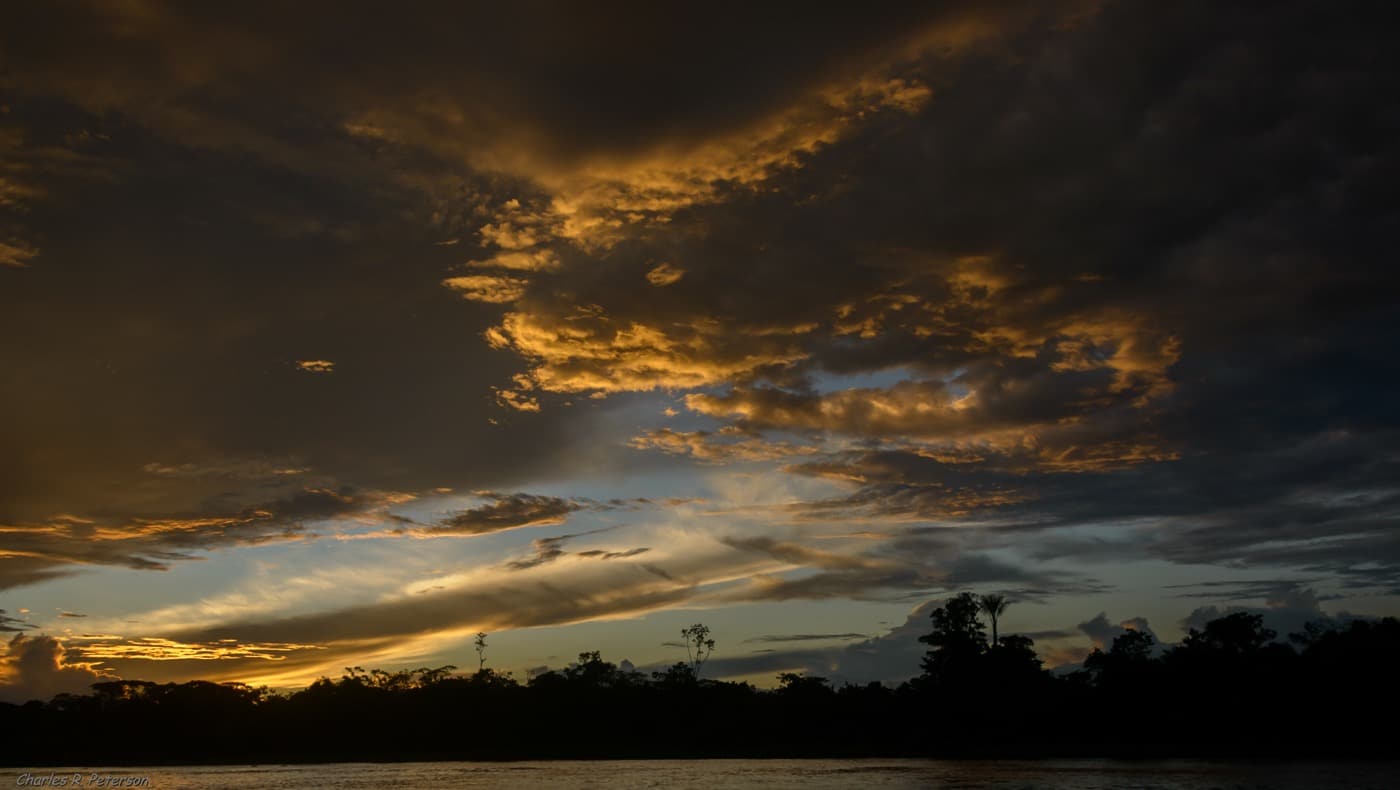Ernest Hemingway came to the Peruvian Coast in 1956—partly to fish for black marlin, partly to oversee the filming of his monumental novel, The Old Man and the Sea. Almost 60 years after his visit, I, too, am heading to the Peruvian Coast. None of my magazine articles have been optioned for Hollywood blockbusters and I won’t be fishing for black marlin, much as I’d like to. Even so, I’ve come in search of a different kind of adventure. For several days, I’ll explore Peru’s central coast, washed by the waters of the Pacific Ocean, which crashes along shores sheltered by dunes and shadowed by the Andes. I’ll visit the Paracas National Reserve, Peru’s sole marine reserve and home of the Islas Ballestas, known as the “Baby Galapagos,” and a UNESCO World Heritage Site. And, when the long day is done, I’ll cool off like Hemingway—and any other self-respecting Peruvian adventurer – with an icy glass of pisco, Peru’s national drink.
Arriving in Lima, I sightsee for a few days before setting out for the coast. With the Pacific at its front and the Andes at its back, the Peruvian capital is a bewitching, if somewhat faded beauty. A sprawling pre-Incan settlement, then an Incan capital, then later a viceroyalty of Spain, Lima intrigues with its multiple layers of history and culture. There are huacas, archeological sites dating thousands of years before the Incans, and beautiful old Spanish Colonial churches like Convento Santo Domingo, with its flower-filled courtyard and multilevel bell tower. Along with sleek restaurants serving Peruvian fusion cuisine, with Chinese and Japanese accents, there are simple places where you can dig into a plate of criollo food, perhaps tacu-tacu, a rice and beans dish with a wafer thin beef filet that’s topped with a fried egg. And, always, there’s a glass of pisco waiting somewhere—perhaps at the English Bar in the fancy 1920’s era Country Club Hotel, in the 1924 Gran Hotel Bolivar on Plaza San Martín or in downtown’s Bar Cordano, circa 1905, where you can taste one of 600 brands.
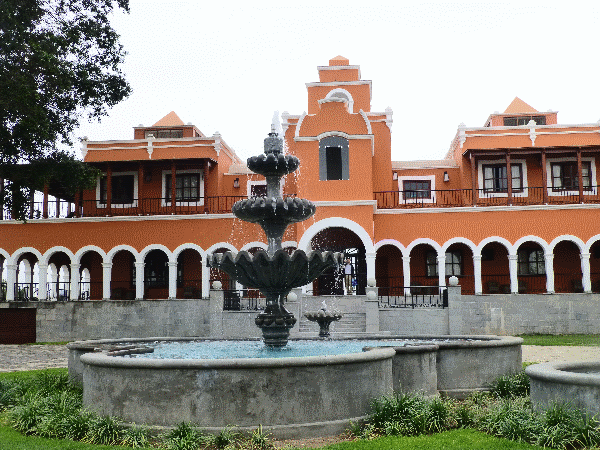
After a couple days, I make the 166 mile trip south to Paracas. On the drive down the Carretera Panamericana Sur, or the South Pan-American Highway, dunes rise alongside the well paved road and the Andes loom in the distance. Around nightfall, I check into the Hacienda Bahía Paracas, a sprawling resort with pelicans roosting on the bay, kayaks waiting on the beach and spacious guest rooms with terra cotta floors and Peruvian textiles on the walls. The cozy Marineros Bar, with a colorful tiled floor and little wood tables, has a plaque marking Hemingway’s 1956 trip to the coast, albeit miles away in Cabo Blanco. And almost leaping across one whitewashed wall is a five foot black marlin with a foot long bill. I’m impressed by its size, but as black marlins go it’s actually pretty small. In Cabo Blanco in 1953, one Alfred Glassell Jr., caught a monster black marlin that was almost 15 feet long and weighed 1,560 pounds, a record that’s never been broken. Hemingway’s big trophy was only 900 pounds!
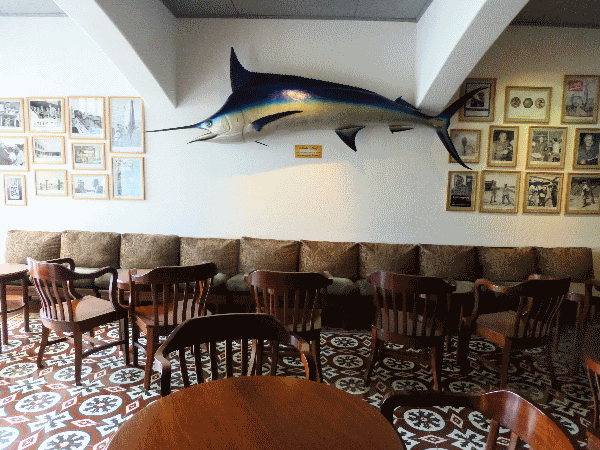
Just up the road there’s a fancier resort, Starwood’s Hotel Paracas. I dine there one night, enjoying views of the infinity pool surrounded by carefully arranged Bali beds in airy shelters. It’s a stunning setting. The excellent but obsessively detailed fusion cuisine—including six of Paracas’ famous scallops each topped with a different sauce or molecular froth—is delivered with well-orchestrated breaks between courses like pauses between movements of a symphony. This is the kind of place where I’d have to come every night perfumed and well dressed, wearing my best linen blouse, tailored slacks and finest Italian loafers. I couldn’t just plop into a chair on the terrace wearing the same dusty jeans, wide brimmed adventurer’s hat and sandals I’d worn all day long. I couldn’t just order some plain sauteed scallops and grilled red snapper, eat them as if wholly consumed by the plate in front of me, then fall right into bed. Which is why (on this particular trip) the Hotel Paracas is great for a fancy meal, but the Hacienda Bahía Paracas, a big, airy country house, is elegant enough for my short stay.
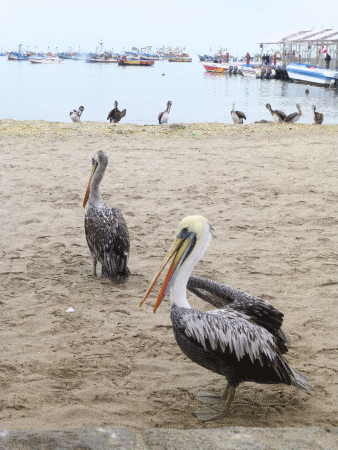
I’m up for an early breakfast of huevos rancheros, beans and o.j. on the spacious terrace, steps from the swimming pool and the swim-up guest rooms. Then I stroll the property’s beach curving along the turquoise bay. A 15 minute drive takes me to the Paracas harbor front, a low slung strip of cafés, tour companies and souvenir stalls where crowds are already queuing up for the motorboat ride to the Islas Ballestas. I hop a 12 seater and am soon speeding out to sea past squawking pelicans and colorful wooden fishing boats.
After a half hour or so, the Islas Ballestas (the double “l” pronounced like a “y”) come into view. Though relatively close to the harbor, these craggy islets, skerries and rocks look like they’ve risen out of nowhere. As we near their shores, and our boat pitches back and forth in the foaming chop, I see why these isles are called the “Baby Galapagos.” Overhead wheel thousands of birds—cormorants, gulls, condors, diving petrels, turkey vultures —while, gray-footed and Peruvian scramble over the rocks along with sea lions, flirting with would be mates and posing for our cameras.
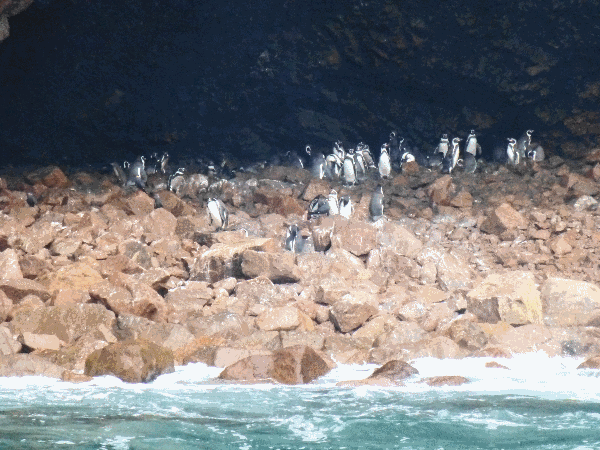
Two foot high Humboldt penguins, in black and white feathered suits, toddle around like miniature Chaplins. Peru, along with Chile, is one of the world’s few places where endangered Humboldt penguins can be found. It’s also one of the few spots where the Humboldt Current flows, starting from Chile’s southern tip to northern Peru. Its ecosystem is the world’s most productive marine environment, the cold, upswelling waters constantly churning up rich nutrients from the deep.
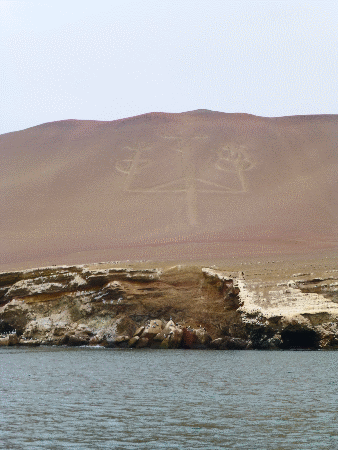
The cruise also offers excellent views of El Candelabro, or the Paracas Candelabra, a 600 foot high geoglyph etched into the north face of the Paracas peninsula. Whether a candleholder, cactus or hallucinogenic jimson weed, a lightning bolt or trident of the long ago sea god Viracocha (or Kon-Tiki), or something left here by early sailors, Freemasons or the crew of the Argentinian General José de San Martín who liberated Peru in 1821, El Candelabro is impressive. Two hours’ drive further down the coast are the more impressive Nazca Lines, stylized geometric shapes of plants and animals, including hummingbirds, spiders, monkeys and sharks. Helicopter tours of these are offered by several tour companies on the Paracas waterfront and from Ica, about 35 miles inland.
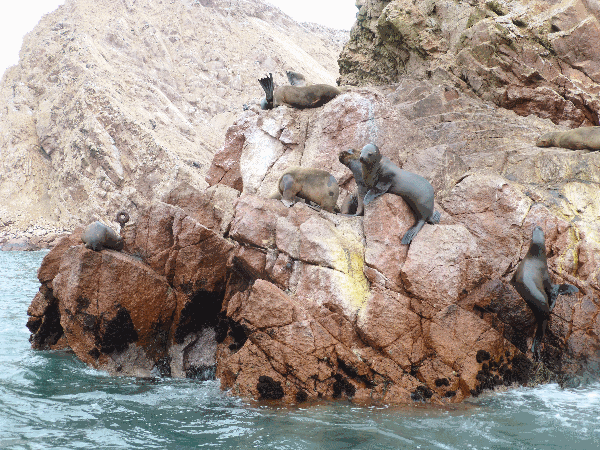
Since I can have an adventure just as easily exploring a new food or drink as I can hacking my way through a steamy jungle or inching up a snow covered mountain, I head to Ica to journey into the heart of Peru’s national drink, pisco. After a 75 minute drive along dusty, winding roads, I reach the melon colored gates of Hacienda La Caravedo. The oldest distillery in the Americas, circa 1684, it’s owned by American investor Bill Kallop and his wife, Cristina. The couple restored the sprawling hacienda with its trio of stone fountains, rebuilt the old outdoor distillery whose wooden press features a giant screw fashioned from a huarango tree and constructed a new state of the art distillery with gleaming copper tanks. On a tour, visitors learn how pisco, a clear grape brandy, is made and taste several varieties of the distillery’s Pisco Portón brand. I spend a couple of hours inside the distillery, and also outside amidst a sea of vineyards beneath the snow-capped Andes, where the owners’ Paso Fino horses often trot with their distinctive lateral gait.
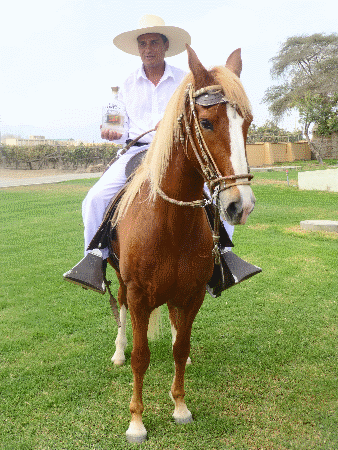
After visiting, I head six miles north to the nearby hamlet of Fundo Tres Esquinas, for dinner at La Olla de Juanita, where Juanita Martínez de Gonzales, the great “Lady of Pisco,” has dished up some crowd pleasing criollo dishes. I order a beef entrée, with a typical Peruvian cheese, chili and milk sauce. While waiting, I’m treated to the world famous Peruvian Pisco Sour—a lime-infused cocktail made deadly with pisco and delicious with a frothy head of whipped egg white—just the ticket after a long, day of exploring and exactly what Hemingway would have done.
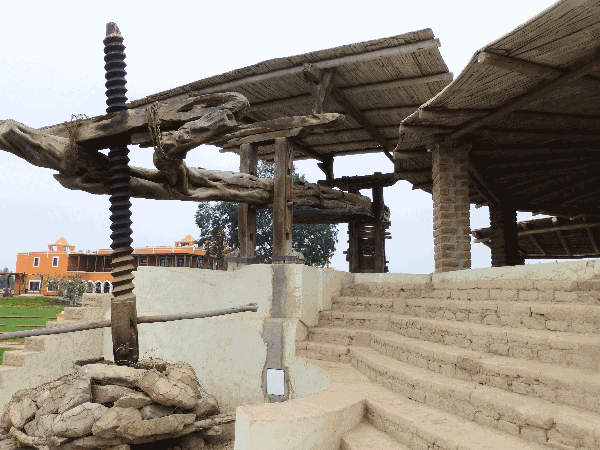
*For help with planning a trip to Peru, there’s no better tool than a DK Eyewitness Travel Guide.
The area code for Peru is 51.
Where to Stay, Eat and Drink:
Hotel Atton – In Lima’s tony San Isidro neighborhood, a stylish spot to overnight before hitting the coast. Av. Jorge Basadre 595, San Isidro, Lima, Peru (1) 2-08-1200. www.atton.com
Hotel Paracas – With a dock on Paracas Bay, Starwood’s stunning 120 room property has a stylish restaurant for Peruvian fusion cuisine, a sprawling infinity pool and a first rate spa. Av. Paracas S/N, Paracas, Peru, (56) 581-333. www.starwoodhotels.com
La Hacienda Bahía – This charming bayfront property has 87 rooms (including swim-up rooms), a beach for kayaking, an Asian influenced spa and a Hemingway inspired bar complete with a black marlin trophy. Urb. Santo Domingo, Lote 25, Paracas, Peru, (1) 213-1000 or 213-1010. www.hoteleslahacienda.com
La Olla de Juanita – Next to the Bodega Tres Generaciones pisco distillery, this country restaurant, owned by the same family, offers the best in Peruvian criollo cooking. Fundo Tres Esquinas, Distrito de Subtanjalla, Ica, Peru, (34) 40-33-17. www.booking.org.uk/laolladejuanita
Las Dunas Sun Resort – This family friendly property offers overnight accommodations, day passes to its mini water park, and tours to the Nazca Lines and other nearby attractions. Av. La Angostura 400, Ica, Peru (56) 256-224 or (1) 213-5000. www.lasdunashotel.com
What to Do:
Paracas National Reserve – Covering more than 800,000 acres, the reserve includes the Islas Ballestas, with sea lions, bird life and Humboldt penguins, nearly a hundred archeological sites of the pre-Incan Paracas people, and the artifact filled Muséo Sitio Julio C. Tello, named after the archeologist who discovered these sites. Carretera Punta Pejerry Km 27, Paracas, Peru, (1) 975-043-564 (Central Office). www.sernanp.gob.pe
Hacienda La Caravedo – Visit the oldest pisco distillery in the Americas to taste Pisco Portón, one of Peru’s premier piscos. South Panamerican Highway Km 291, Ica, Peru, (1) 711-7800. www.piscoporton.com. For tours, e-mail tourslacaravedo@piscoporton.com .

